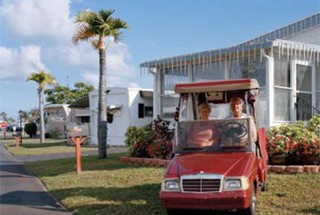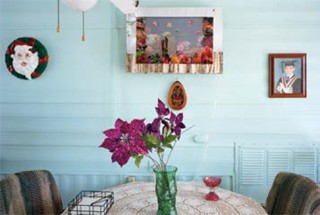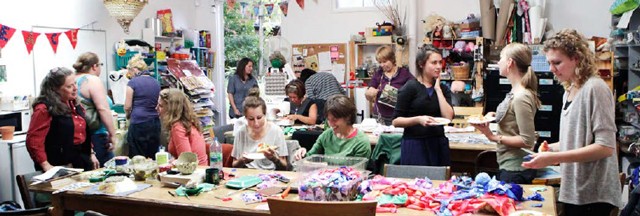Faculty spotlight: Fine Arts
Something special is clearly going on at Concordia’s Faculty of Fine Arts. Its visual artists, past and present, have been reeling in awards in competitions in Quebec and across the country in recent years.
From Governor General awards and Pulitzer prizes to the Order of Canada, the Department of Studio Arts’ students, professors and alumni are obviously doing something right. (See “Awarding work.”)
“The energy coming from peers, the support provided by faculty and the presence of so many engaged artists coming together are creating a kind of synergy,” says Janet Werner, chair of the department. One of Werner’s own works, Earthling, was acquired in January by Montreal’s Musée d’art contemporain, a major accomplishment.
The first factor she attributes to a good showing from Concordia-affiliated artists is size. Studio arts is the largest department in the Faculty of Fine Arts, with just over 1,300 undergraduate and graduate students and about 100 full- and part-time faculty members spread across a dozen disciplines, from painting to cyberarts. “There’s a critical mass — it’s big, but not too big,” Werner notes. “Size matters.”
And the calibre is top-notch, especially at the graduate level. “The competition to get in — to teach as well as study — makes for strong faculty and students,” she notes.

 Mika Goodfriend, BFA 12, took top spot at the BMO 1st art! Invitational student art competition in August. Pictured Is Benoit et Suzanne, Reynald et Marylda, from Goodfriend’s snowbirds series, a visual exploration of Québécois identity and culture in a Pompano Beach, FLA., retirement community.
Mika Goodfriend, BFA 12, took top spot at the BMO 1st art! Invitational student art competition in August. Pictured Is Benoit et Suzanne, Reynald et Marylda, from Goodfriend’s snowbirds series, a visual exploration of Québécois identity and culture in a Pompano Beach, FLA., retirement community.
In a typical year, for example, Concordia’s Master of Fine Arts in Studio Arts program welcomes just one in six applicants. The program, one of Canada’s first, has maintained an international reputation for 30 years. MFA student Betino Assa earned an honourable mention — worth $15,000 — in the 2012 RBC National Painting Competition, while in January student Paul Butler was named curator of contemporary art at the Winnipeg Art Gallery.
Success attracts success, as well. Keen to help nurture promising talent, donors such as Sean B. Murphy, Nick and Dale Tedeschi, Stephen and Claudine Bronfman and Dick and Gretchen Evans provide outstanding support that, in turn, helps emerging artists at Concordia focus and flourish in their practice.
The city itself can take some credit for the success of Concordians, too. Chock full of art galleries, museums and exhibitions, Montreal enjoys a vibrant and participatory arts scene that offers myriad possibilities for students to exhibit their artwork. Its history of artist-run galleries is attractive, too.
“People stay here after graduation because there’s a lot of opportunity to show their work in a meaningful way at all levels,” says Emily Jan, a third-year MFA student. “Montreal is an amazing arts city.”
Art hives buzz with activity
Take one modest storefront on a street in a working-class neighbourhood; fill it with donations of paints, fabrics and other recyclables; throw open the doors to the community to come make art. What do you get? A community art hive. Or, in French, a ruche d’art.
 Janis Timm-Bottos, far left, at La ruche d’art community studio and science shop in Montreal’s St-Henri district.
Janis Timm-Bottos, far left, at La ruche d’art community studio and science shop in Montreal’s St-Henri district.
Art hives are the research focus of Janis Timm-Bottos, an art therapy professor with Concordia’s Department of Creative Arts Therapies. While open to everyone, this social-inclusion initiative especially welcomes those living on society’s margins. There are no instructors; participants learn from and teach each other and, in the process, share ideas about local social and cultural issues. These studios “provide opportunities to share abilities and develop leadership skills while giving back to the community,” Timm-Bottos says.
They provide other opportunities, too. Timm-Bottos teaches one of her university courses at La Ruche d’Art Community Studio and Science Shop in Montreal’s St-Henri district. Several Concordia graduate students are involved as research assistants, volunteers and art therapy interns. “The storefront studio provides an outlet and access to learning directly in the community,” she says.
Timm-Bottos is now focused on helping plant the seeds of a national network of neighbourhood art hives. The J.W. McConnell Family Foundation has given a $300,000 grant to help her spread the word across Canada; trips are scheduled from Corner Brook, N.L., to Vancouver Island.
“For these partners — the university, the private funders and the community — to come together to create free spaces for people to inquire about themselves, about their neighbourhoods, about each other, is wonderful,” Timm-Bottos says.